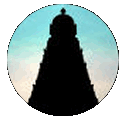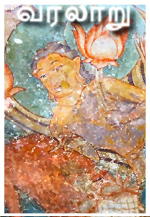 |
 |
 |
http://www.varalaaru.com A Monthly Web Magazine for South Asian History [186 Issues] [1832 Articles] |
 |
 |
 |
http://www.varalaaru.com A Monthly Web Magazine for South Asian History [186 Issues] [1832 Articles] |
|
Issue No. 132

இதழ் 132 [ ஜனவரி 2017 ] 
இந்த இதழில்.. In this Issue.. 
|
Chandrasekaraswami Temple or Thiruchchendurai Karrali Mahadevar Temple
THE MAHA MANDAPA The mukha mandapa and the maha mandapa are connected by a small passage, a closed provision. The walls of the passage lack sectioning and constructed out of stone blocks. The maha mandapa is a pillared hall and bigger than the mukha mandapa both in length and breadth. The walls of the maha mandapa have pratibandha adhishthana, bhitti and prastara, but the prativari of the adhishthana alone is visible at present whereas the rest are inhumed in the ground. The yazhis of the prati series are shallow carving. Six pilasters on the north and south, two pilasters on the western side canton the bhitti of the mandapa and the pilasters are brahmakantha and possess head components viz., kattu, kalasa, tadi, kudam, pali and phalaka. The head components lack embossed ornamentation as found in mukha mandapa and vimana. The potikas are at some places vettu and at some places angular and bear the uttira. Vajana, valabhi and kapota forms the other prastara elements. The kapota is ridged and also adorned with kudus, at some instances it is shallow and at some instances only provision is seen. The roof is covered with stone slabs and the bhumidesa above it. The bhumidesa is plain but provision for makara is seen at the corners. Brick and tile finishing is seen above the roof. Both the bhumidesa and the valabhi are plain. Windows are seen on the northern and southern sides. The pillars inside the mandapa possess three squares and vishnu kattu ornamentation in between with padmakattu at both ends of the vishnu kattu. The vettu potikas that rest above the pillars bear the prastara of the mandapa. Roof slabs are laid to cover the roof of the mandapa. Closed provisions are seen on the western corners of this mandapa. THE OPEN PILLARED MANDAPA The space in between the second gopura and the maha mandapa is covered with an open pillared mandapa and the pillars carry the same features as found in the maha mandapa. But here the squares are adorned with medallions. Few of the potikas are madalai and nunudal. The goddess shrine lies on the northern side of the mandapa. Navagraha and Bikshadana are on the eastern side of the mandapa. Uchchhishta Ganesa is seen on the western side of the mandapa. SCULPTURES VRISHABHARUDHA The southern koshtha is adorned with Vrishabharudha. The god is standing on a pedestal with his right leg in sama and the left leg in trysra. His front right hand is in katyavalambita whereas the front left hand is resting on the Nandi who is standing behind. The back hands are in kataka mudra and carry akshamala in the right but the object in the left hand is not clear. The braids are arranged as jatamakuta in the apex besides head ornament, flowers, skull, crescent moon are decked in the matted hair. His elongated ears are adorned with kundalas; patrakundala in the right and makara kundala in the left. A short attire is draped around the lower body which is fastened by an ornamental hip belt. In addition, the idaikattu is slackly worn above it, heavy knots of it are seen on both the sides. The yajnopavita is worn in upavita fashion. The deity is decked with various ornaments viz., charapali, kandigai, bangles, keyura and udarabandha. In both the hands fingers are adorned with rings. The Nandi is standing cozily with the God with his head on the left side of the God. Though the sculpture is much dilapidated still exhibits the prodigy of the Early Chola sculptors; an excellent poise has been maintained by the sculptor. Slight leaning of God by resting his front left hand on Nandi who is to his left and a light tilt of the head on right side gives an excellent posture. Besides, the God in slim structure, richly adorned ornaments and the untied braids spreading on the shoulders, all add gorgeousness to him. UCHCHHISHTA GANESA Ganesa is seated in maharajalilasana on a pedestal with his front right hand in kataka and holding the broken tusk and his front left hand is embracing the goddess seated on his left lap. The back hands are in kataka mudra and also carry objects; parasu in the right and pasa on the left. He is adorned with karanda makuta, short attire, charapali, udarabandha and yajnopavita. His proboscis is touching the private parts of the goddess. The goddess seated on the left lap of Ganesa is decked with karanda makuta, kundalas, charapali and other ornaments. A short attire drape the lower part of her body but the breast band is absent. Her left hand is carrying a flower whereas her right hand is stretched to her side. It is a unique sculpture rarely found in Tamil Nadu. One such sculpture is found in Nagaswaraswamin temple in Kumbakonam and Okaliswaram in Malayakkoil in Pudukkottai district.
DVARAPALAS Both the dvarapalas are masterpiece of early Chola sculpture. They are standing on the pitha in dvibanga posture with their lower body twisted towards sanctum and the upper body facing straight. The dvarapala in the north has placed his right leg on the pedestal in parsva and the left leg is lifted up and placed on the machete of the cylindrical plank held by him to his right, whereas his counterpart placed his left leg on the pedestal in parsva and the right leg is lifted up and placed on the tree branch held by him on his left. The dvarapalas have positioned their one hand in mudra and the other hand on the plank; the right hand of the northern dvarapala is in vismaya and the left hand is holding the cylindrical plank placed to his right. His counterpart is holding the tree branch on his left hand and the right hand usually in darjani mudra is unfortunately got mutilated. For both the dvarapalas the attire and ornaments are similar. Both are lavishly decked with stone and pearl studded ornaments. Locks are formed as braids, a tuft is matted as jatamakuta in the apex and a portion of braids in the lower head are beautifully curled and left untied spreading behind. The makuta is ornamented with pearl strings that hang throughout and head patta adorns the fore head. Ears are elongated and adorned with owl kundalas. A heavy stone and pearl studded neck ornament is adorned by them, in addition, pearls strings also dangle in the neck ornament. The arms are adorned with bangles in the wrists, simhamukha armlets in the upper hand. Pearl strings also hang in the armlets. Yajnopavita is worn in upavita fashion, it has four different stings and the brahmasutra is shown as flower brooches. Both are adorned with udarabandha which possess brooch and pearl strings. Their lower garment is a short attire (marauri aadai) fastened by stone studded hip belt, excess noose of the hip belt dangle in the front. Idaikattu is slackly worn above the lower garment, the tussles of the knot hangs on sides. Both the dvarapalas are adorned with anklets in addition the northern dvarapala is also adorned with anklet in the calf. A snake is seen with its raised hood behind the left shoulder of the northern dvarapala whereas for the southern dvarapala it is on the right shoulder. The dvarapala in the north is holding a plank which has heavy cylindrical body with a trimmed handle and pointed tip. The tree branch held by the southern dvarapala is also a heavy twig. Two holes are seen on the branch; one in the lower part of the twig and the other in the upper part. A snake is seen emerging out of the lower hole and chasing a rat that runs furiously. Besides, a reptile is also seen climbing the branch.
BHAIRAVA Bhairava is standing on a pedestal in sama in nude posture with a dog behind. His locks are arranged as sudarmudi, raised up like flames that form a triangular shape and decked with head patta. The vastara yajnopavita is worn in upavita fashion and while a portion of the vastra extend upto his calf. All the palms are in kataka mudra and also carry objects; among the right hands the front hand carry sula and the back hand carry damru, among the left hands, the front hand carry kapala and the back hand carry snake. Kandigai, Chavadi and charapali adorn his neck, anklets are worn in the ankle, the ears are elongated and decked with patrakundala in the left and makara kundala in the right. Bangles, armlets and shoulder ornament are adorned in the arms. A snake entwines the lower body of the deity. Tusks and wide open eyes exhibit the fierce nature of the god. Ornamentation and the other sculptural traits authenticates that the sculpture might belonged to later Chola period. The dog standing behind the god is with its ears erupt, mouth wide open exposing the canines and tail scroll in erupt posture. The dog is also decked with beaded ornament in the back and the neck.
|

சிறப்பிதழ்கள் Special Issues 

புகைப்படத் தொகுப்பு Photo Gallery 
|
| (C) 2004, varalaaru.com. All articles are copyrighted to respective authors. Unauthorized reproduction of any article, image or audio/video contents published here, without the prior approval of the authors or varalaaru.com are strictly prohibited. | ||